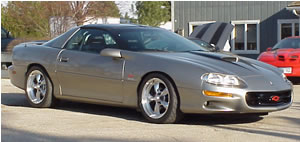As it turned out, we discovered that a stack up of manufacturing tolerances in the stroker crank and rods was creating enough variation in piston protrusion height to affect compression. This, in turn, caused a slight enough difference in power, cylinder-to-cylinder, to affect crank speed and mislead the OBD II system into thinking there was a misfire problem occurring.
General Motors says that there should be no more than a .010" variation in deck height, otherwise it may affect the misfire detection capabilities of OBD II system. What I found was that if the piston protrusion height varied more than .008", it would cause a problem.
On the next LS1 motor we built, we kept the piston protrusion height to within .0015" on every cylinder and equalized combustion chamber volumes to within half a cubic centimeter. This eliminated the false random misfire code problem.
When you're building an OBD II compliant motor, you need to check stroke length, rod length and piston height. By mixing and matching parts, you can equalize piston protrusion to minimize the risk of a false misfire code. You can also compensate for variations in piston protrusion height by adjusting the volume of the combustion chambers. One way to do that is to recess the valves slightly in the head to alter displacement of the combustion chamber.
If you don't know how sensitive the OBD II system is to variations in combustion chamber volume, piston protrusion, and compression, you can end up building problem motors that turn on the OBD II light - and you won't know why it's happening.
Project 302

In my next column, I'll detail everything we did to the engine. But basically I opted for a mechanical roller cam to handle the higher rpms, upped the compression and modified the heads to improve low end torque.
When you're building a street performance engine, you want to keep port velocity high to improve torque at low rpms. Tall narrow ports and intake runners are better than larger ones because they keep the airflow velocity high. You also have to pay careful attention to the profile of the intake ports and the shape of the combustion chambers so you get good airflow past the intake valves.
As for the camshaft, I like a high lift, short duration cam with lots of ramp speed to open the valves quickly. You also have to pick the right lobe centers and separation to get food low-end performance and emissions. Advancing the lobe centers helps low rpm torque on the street.
The finished 302 met all of our performance goals, including being OBD II compliant. The motor put out over 400 horsepower and could wind safely to 7,500 rpm.
Yet, it could idle at 850 rpm with plenty of intake vacuum and pull away from a stoplight without hesitating or having to feather the throttle. Best of all, this car can really light up the tires when you punch it! AR
Accelerated wear or other valve control system problems are also likely because the replacement valves may no be properly lubricated. The OE engine il system was designed to work with a lubricant impregnated into the powdered metal guide. The replacement valves and guides may be starved for oil. Button up the job, send the car out the door and a few thousand miles later your customer is back with a valve control system that's a disaster. By traditional rebuilding standards, you didn't do anything intentionally wrong. You were just blindsided by installing a part that fit, but which didn't meet OE specifications.